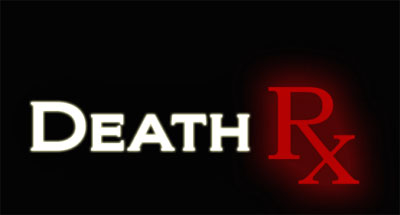|
A Promising Drug With a Flaw was the name of an article published in the New York Times this past week.
Pradaxa has been linked to more than 500 deaths in the United States, demonstrating that in our current civilization it is fine to make a fortune killing people.
Though a chorus of complaints has risen from doctors, victims’ families and others in the medical community, the FDA is not worried that its approval process was not sufficiently rigorous.
They are not at all concerned that they allowed a dangerous drug to be sold without an option for reversing its effects.
They sleep at night, the whole lot of them over at the FDA, CDC and all the other health and medical organizations in the United States and Europe knowing that over 100,000 Americans die from their properly-prescribed medicines each and every year.
The Food and Drug Administration released a report on Friday that found that the drug did not show a higher risk of bleeding than for patients taking warfarin. The report did not address the lack of an antidote for Pradaxa.
What does the pharmaceutical company who makes the drug say?
Magnesium Medicine
Magnesium
deficiency can cause metabolic changes
The hidden subject, and one of the most important for the world of medicine, is that this anti-clotting anti-stroke medicine is no match for magnesium chloride when it comes to either treating or preventing strokes.
Magnesium chloride is a true medicine where Pradaxa is a true pharmaceutical poison especially designed to make money not heal people of their diseases.
In my
practice the use of magnesium in the early
In Los Angeles, California, the FAST-MAG trial, has ambulance personal injecting magnesium sulfate quickly upon arrival to stroke victims.
The Field Administration of Stroke Therapy (FAST-MAG Trials) is an NIH-NINDS-sponsored study whose goal is to evaluate the effectiveness and safety of field-initiated magnesium in improving the long-term functional outcome of patients with acute stroke.[1]
The FAST-MAG trial addresses the crucial factor of delayed time to treatment that has hindered all past human clinical trials of neuroprotective drugs.
The FAST-MAG Pilot Trial demonstrated that field initiation of magnesium in acute stroke is feasible, safe, and potentially efficacious. The basic design is to inject magnesium within 1-2 hours of onset of stroke when the benefits of neuroprotective acute stroke therapies are likely to be greatest.
By utilizing field delivery via the ambulance, medical scientists are conducting the first neuroprotective study ever performed in the 0-2-hour window.
Most stroke patients typically don’t receive treatment within these brief windows. Patients typically arrive at the hospital too late; and the consequences as such are great.
Now many stroke patients are being given magnesium sulfate within 30 minutes and in July 2012 it was also reported that 37% of FAST-MAG ischemic stroke patients received TPA, the clot-dissolving medicine tissue plasminogen activator.
This high treatment rate will allow FAST-MAG to identify any potential synergistic benefits of magnesium and TPA.[2]
Researchers believe that magnesium slows the chemical process that can kill 12 million brain cells per minute during an untreated stroke, leading to long-term disability and death. So every moment is crucial to outcome. At least nine preclinical studies have examined the effect of systemic magnesium sulfate upon final infarct size in animal focal ischemic stroke models.
Eight of the nine demonstrated substantial decreases in infarct size in treated animals, with reductions ranging from 26-61% in studies.
Early
studies using rats and mice showed that if given at high
Dr. Gregory Lip, professor of cardiovascular medicine at the University of Birmingham, says that the majority of strokes are preventable, but under-diagnosis and poor care, as well as under-use of medicines and the side effects of drugs means stroke creates “an unnecessary and heavy burden” on patients and health systems.[4]
Stroke is the most common cardiovascular problem after heart disease and kills an estimated 5.7 million people worldwide each year.
Dr. Vega continues,
An essential prerequisite for any pharmacological agent to offer significant brain neuronal protection during strokes is its ability to freely cross the blood-brain barrier.
Several studies show that magnesium crosses the blood-brain barrier in both animals and in humans.
Magnesium ions cross the intact blood-brain barrier efficaciously so that intravenous magnesium sulfate or chloride significantly raises cerebrospinal fluid and brain extracellular fluid magnesium to supraphysiologic levels.
Ancient Minerals has put together a page on their site that makes it easy to tell if you are magnesium deficient. But don’t expect mainstream allopathic doctors to even think about magnesium. They will not be asking these questions or be predicting heart attacks or strokes anytime soon.
Prescription drug deaths now outnumber other deaths in the U.S. Prescription medications have become the leading cause of illness, disability, and death.
Many medications’ side effects are worse than the conditions for which they are prescribed. These deaths are from accidental overdoses, from the inherent side effects of the drugs, and also taking two or more prescription drugs at the same time.
Most drugs approved by the FDA are under-tested for adverse drug reactions, yet offer few new benefits. Drugs cause more than 2.2 million hospitalizations and 110,000 hospital-based deaths a year.
Serious drug reactions at home or in nursing home-care not counted in this number, so certainly the number of deaths is significantly higher.
Special Note If you suspect a loved one is suffering a stroke, if you have access to magnesium oil, while waiting for the ambulance, rub the magnesium all over the person’s body or, in the case of a child, quickly put the child in a bath loaded with magnesium chloride, recommended are 2-5 pounds of magnesium flakes in a full bath for an adult with an added pound or two of sodium bicarbonate with much less for children of course.
This will not replace an injection of magnesium that could be offered by the ambulance operators (but is usually not, except in L.A.) but it opens up quick intervention that will help.
One can also drink magnesium chloride. The point is: the quicker one intervenes, the greater the chance of a quicker and more complete recovery.
References
|


